| PEMBROKE PINES BALD EAGLES |
| Nest Watch Page |
| History of the Eagle Nest |
| Eagle Watch FORUM |
| FAQs |
| IMPORTANT Since the chicks are almost ready to fledge, we ask observers to spread their time as efficiently as possible. If you plan to stand watch for an hour or more, please post a reply to THIS MESSAGE in the FORUM with your intended hours in the Subject line, so that others can fill in during times that no one is Scheduled. OK to post as late as the night before or early the same morning. Thanks! |
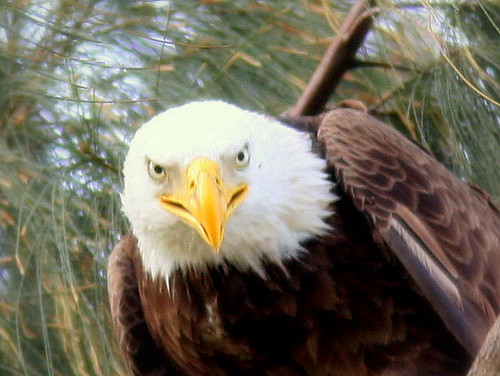
We are pretty sure that we can tell the two Bald Eagle chicks apart. The first egg was laid on December 13 and it hatched on January 17th. The second hatched about 5 days later. Early on, there was a great size difference between the two chicks. For the first three weeks they both sported coats of whitish down. Gradually the down was replaced by black feathers, The younger chick was only a day or two behind its nest-mate in losing the last bit of down, which clung to its head like a white fur skullcap.
Now that both chicks have names and are aver 9 weeks old, the size discrepancy remains. Hope, the older one, also is much more active and aggressive. When a parent brings food, Hope eats first, while Justice usually sits passively on the far side of the nest. After several minutes, he will move toward the adult and beg to be fed. A couple of times his begging appeared to be ignored, while the adult actually fed on the last of a white bird (ibis or egret) that it brought in. Commonly, the adults are simply dropping the prey into the nest and the chicks then tear at it. Justice appears to actively feed himself, though a few times Hope seemed to be keeping him away from food left in the nest. Hope is also more actively flapping her wings and even lifting off in practice flight. She sometimes rises up to two feet vertically. Both take turns rushing and flapping back and forth across the nest.
The adults can be told apart, but the only readily noticeable difference is the larger size of the female. Some say this male’s plumage is a bit darker, but I do not see that. There is a subtle difference in the shape of their bills. I have compared photos and determined the ratio between the height of the bill at is base and the length (from iris of eye to farthest point on the rounded tip). The female has a slightly greater ratio of base to length, a bit over 0.5, while the male’s is less than 0.5. This gives the impression that the male has a proportionally longer and slimmer bill. However, I do not see this in the field, but only in photos where I already know the sex by their size. (I use the eye as a referencce point because it is often difficult to see where the gape of the beak actually starts.)
Here is a comparison. This is the female’s head (she seems to have a more noticeable ridge in front of the nostril):
Here is the male:
These views are not entirely comparable. In fact, look at the male’s bill from a different angle– it appears very thick and short (it also appears to have a slightly more prominent side “tooth”):
Here, Hope watches as the male parent tears off a bit of meat (with feathers attached) before feeding it to her: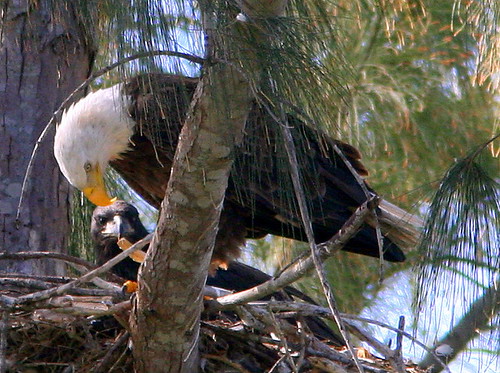
The chicks squabble over the food after the parent departs. The smaller Justice is on the left, and has just been struck by Hope’s wing:
Viewing and photography conditions were rather bad this morning, as the gusty wind seemed to always keep some kind of greenery between us and the chicks.
One real treat was the appearance of a flock of 50 to 60 Cedar Waxwings, which wheeled back and forth around the nest tree (note that one seems to be carrying a feather in its bill):













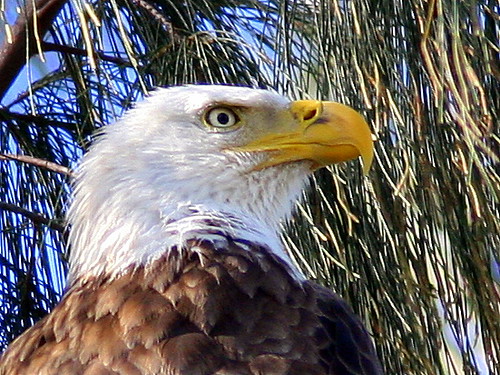

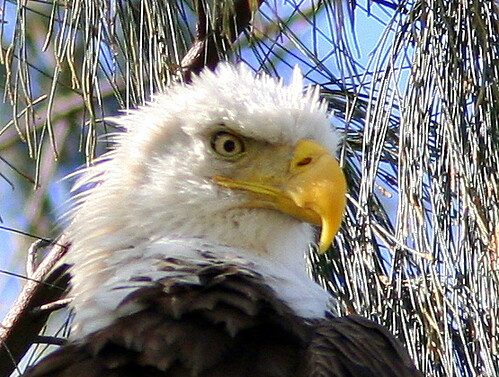
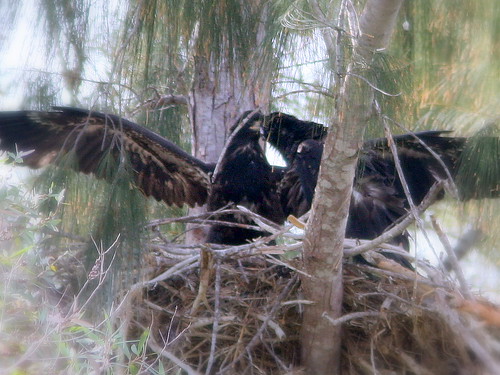
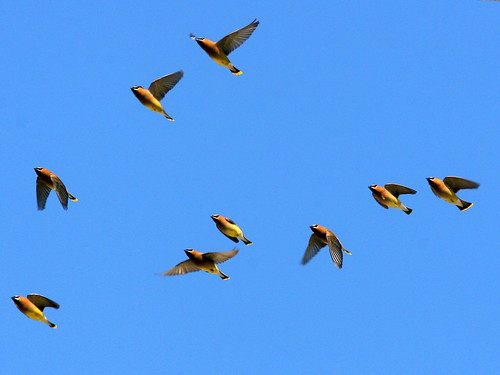
March 27th, 2009 at 8:41 am Hey Ken and Mary Lou, I am glad we ran into you on Wednesday while we were looking at the Eagles. It is always nice to talk to people who have a love for birds and nature. The photos on your site are beautiful. I see you got a good shot of the Cedar Waxwings that flew over us. I hope to one day use my camera as you are. I will have to take a few more lessons from my friend who was showing you how to use your camera on the manual setting. Thanks for all the information and keep me posted of any new developments with our Eagles. Warmest regards, Linda
April 5th, 2009 at 4:11 pm Kan and Mary Lou, I thoroughly enjoy your pictures and word of the eagles. I love to talk with others who sare my love of nature, and birds. It is good to know that there are still people out there who care. Is there a local bird group that I could hook up with. I love to watch birds and to take pictures. Thank you and keep up the great work!!!
April 6th, 2009 at 4:46 am Thanks for your comments, Kathy. Broward County Audubon (affiliate of National Audubon) and the Tropical Audubon Society are the main local groups. The best way to hook up is to go to their Web sites and join one of their field trips. The TAS Bird Board is a great starting point– it has sightings and a link to their field trips, most of which are actually more accessible to us in south Broward County. The Broward Audubon Web site also has field trips. Both have very useful information about nearby birding locations. Good birding! Ken